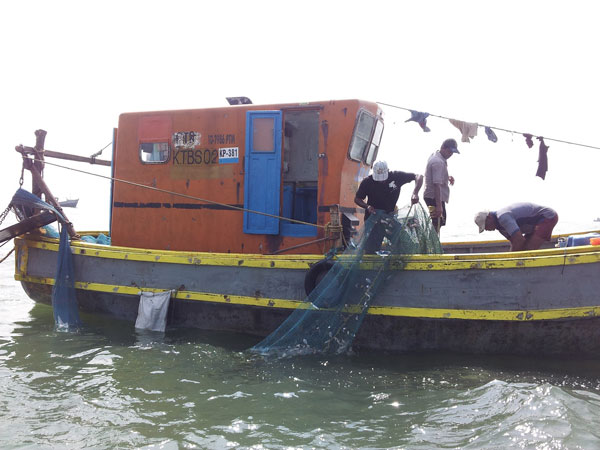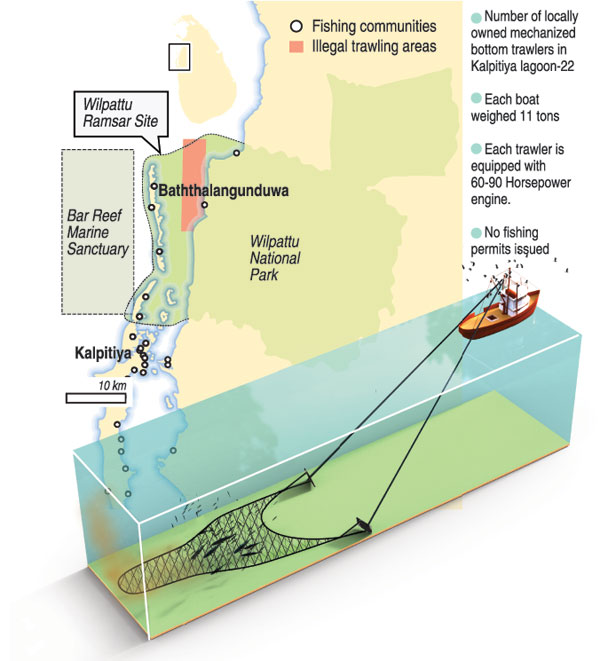News
Bottom trawling ban produces good catch for fishermen in Puttalam and Kalpitiya lagoons

A temporary ban on bottom trawling in the Puttalam and Kalpitiya lagoons from December 31 has resulted in a good catch of prawns, fish and shrimp after years for local fishermen who use traditional fishing methods.
At least 3,000 fisher families from 23 fishermen federations in the district depend on fishing as their sole livlihood in and around the lagoons.
Earlier, some 22 local vessels engaged in bottom-trawling in the lagoon which is included as part of the Wilpattu Ramsar wetland cluster. According to the demarcation brief of the wetland cluster, its Western boundary covers up to ten kilometres from the western coast that includes the Battalangunduwa and Palliyawatte islands.
Sinnakudiyiruppu fishermen Pappai Maraikkaar Mohammed Basheer said local fishermen had been protesting against the illegal bottom trawling for years but a temporary ban brought some relief to fisher families. The local fishermen who engage in traditional fishing methods alleged that their catch was reduced significantly due to extensive trawling carried out by bottom trawlers.
“We can see the impact of the temporary ban with the decent catch of fish and prawns nowadays. Before the ban came to effect, we could not get even one-third of what we get now,” Mr. Basheer said explaining that the absence of trawling allowed fish banks and prawns to reach the coast for breeding purposes. He said local fishermen now targeted selected varieties for harvest depending on the season to ensure the sustainability of the limited marine resources in the lagoons. 
According to the Information Sheet on Ramsar protected Wilpattu National Park, extensive seagrass patches are common in and around river estuaries and shallow sea beds off the coast of the park and around two offshore islands Battalangunduwa, and Palliawatta.
The seagrass beds bordering the shallow coastal waters of the Wilpattu National Park are an important habitat of the globally threatened Dugong (Dugong dugon), a maritime mamal.
However, when the bottom trawlers without legal licences carried out extensive trawling throughout the week except on Sundays, the local fishermen experienced a reduced catch as fish banks were diverted or got caught in the trawling nets. The locally owned mechanised bottom trawlers weigh up to eleven tonnes each and are equipped with 60-90 horsepower engines.
In the Puttalam district, some 23 fishermen federations took up the issue with the local authorities to temporarily stop the trawling in lagoons.
A similar temporary ban came to effect in 2018 following protests by fishermen but later the ban was removed with political influence, local fishermen alleged.
In 2017, the bottom trawling practice was banned in Sri Lanka with the passage of an amendment to the Fisheries and Aquatic Resources Act.
The law makes it illegal to either fish from, operate, or own a boat engaged in bottom trawling. The offence carries a fine of Rs 50,000 and up to two years of imprisonment. The law also makes illegal the import of bottom trawling equipment.
Puttalam Fishermen Federation President A.D. Suranjan Fernando told the Sunday Times that his organisation urged the Fisheries Ministry to continue with the ban on bottom trawling to ensure the livelihood of fishermen in the district.
“Our fishermen are getting a good catch after nearly ten years. They should be allowed to engage in fishing as they used to, rather than allowing a group of trawlers wiping out the fish in the lagoon at a huge cost to marine resources,” Mr. Fernando said.
In 2020, the National Aquatic Resources Research and Development Agency (NARA), the research arm of the Fisheries Ministry, came under severe criticism for recommending specific sea areas across the country for bottom trawling by locally-owned mechanised trawlers.
Initially, the agency had identified four sea regions in the country’s territorial waters for trawling practices. The identified places include the Delft in Jaffna, Pesalai in Mannar, Negombo, and Hendela in Wattala. In these areas, a significant number of local trawlers carry out trawling despite protests by local fishermen.
A NARA Commissioned study titled “Optimising trawl length for sampling prawns at Kalpitiya” (2009) was carried out to compare the capture efficiency of 1 kilometre (km) and 2 km trawls for prawns harvest.
Of the 41 of the 45 sites sampled in the trawling grounds had prawns in the catch, the study found, but expressed concerns that fisheries managers need to carefully weigh up the advantages and disadvantages of trawling in the unfished waters.
The best way to say that you found the home of your dreams is by finding it on Hitad.lk. We have listings for apartments for sale or rent in Sri Lanka, no matter what locale you're looking for! Whether you live in Colombo, Galle, Kandy, Matara, Jaffna and more - we've got them all!

